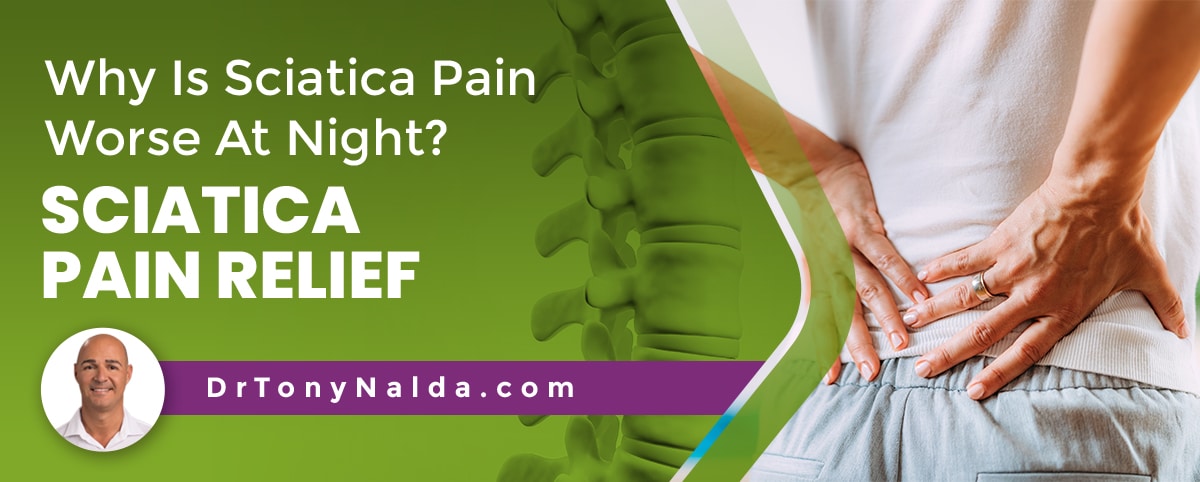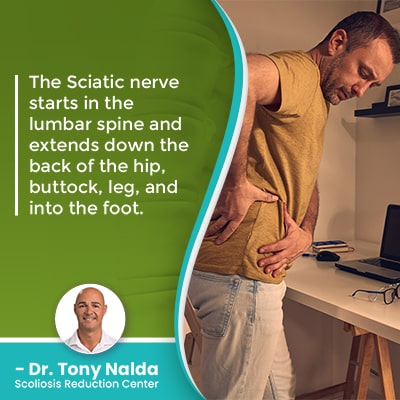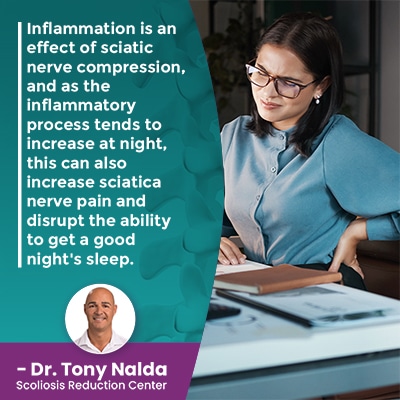Why Is Sciatica Pain Worse At Night? Sciatica Pain Relief

Anyone who has experienced localized back pain and/or back pain due to nerve compression knows how disruptive it can be; nerve-related back pain is commonly regarded as the most debilitating, and when the sciatic nerve is exposed to uneven forces, sciatic nerve pain can become problematic.
While most people consider sciatica a condition itself, it's not; sciatica refers to a set of symptoms that include sciatica pain and discomfort felt anywhere along the sciatic nerve's pathway. Sciatica pain tends to be worse at night due to pressure points, pain, and the inflammatory process.
The spine helps us to stand upright, practice good posture, move flexibly, and works with the brain to form the body's central nervous system, so let's start with some basic spinal anatomy.
Table of Contents
Understanding the Spine
The spine is a complex structure with many moving parts, and not only does it give the body structure and flexibility, the spinal cord within works in tandem with the brain to form the body's central nervous system (CNS).
The spine has three main sections: the cervical spine (neck), the thoracic spine (middle/upper back), and the lumbar spine (lower back).
Each section has its own unique roles to play in maintaining spinal health and function, and each section has its own characteristic curvature type, and these healthy spinal curves make the spine stronger, more flexible, and better able to handle mechanical stress incurred during activity.
The spine consists of vertebrae (bones) that are stacked on top of one another in a straight and neutral spinal alignment, and the vertebrae are separated by intervertebral discs.
The spine's intervertebral discs play many important roles in maintaining spinal health and function; they give the spine structure (adjacent vertebrae attach to the disc in between), flexibility, act as the spine's shock absorbers, and provide cushioning between vertebral bodies so friction isn't generated during movement.
The discs have two main structures: a tough outer later known as the annulus, and a soft gel-like interior known as the nucleus, and the spinal discs are generally the first spinal structures to start to deteriorate.
In fact, when it comes to the development of a number of spinal conditions/issues, including sciatic nerve pain, degenerative disc disease is often a contributing factor.
Now that we have a basic understanding of spinal structure and function, let's focus specifically on the sciatic nerve.
The Sciatic Nerve
 The sciatic nerve starts in the lumbar spine and extends down the back of the hip, buttock, leg, and into the foot.
The sciatic nerve starts in the lumbar spine and extends down the back of the hip, buttock, leg, and into the foot.
In most cases, sciatic nerve pain is felt down the body's left side, but it can affect the right, and rarely affects both.
The sciatic nerve is the largest in the body with an extensive pathway that runs the length of the lower body, which is where the effects of sciatic nerve compression are most likely to be felt.
The sciatic nerve is considered a mixed nerve because it contains both sensory and motor fibers, and this is why sciatic nerve issues can cause symptoms that involve both sensation and movement.
If the sciatic nerve is exposed to uneven pressure (compression) at its root, where it exits the lumbar spine, or anywhere along its extensive pathway, a number of symptoms can develop.
What Does Sciatica Pain Feel Like?
With approximately 10 to 40 percent of the population experiencing sciatic nerve pain, it's a highly-prevalent issue that warrants awareness.
Sciatic nerve pain can range from mild and intermittent to chronic low back pain that's debilitating.
In many cases, there are flare ups, during which time, symptoms are intense and then abate, and some cases resolve on their own in a matter of weeks, but when severe, proactive treatment is needed.
The frequency of flare ups will depend on the underlying cause of the sciatic nerve pain.
When the sciatic nerve is compressed, and/or if there is a loss of space for the nerve to function within, it can become irritated, pinched, inflamed, and/or impinged, and this is when sciatica symptoms will develop.
When the sciatic nerve is exposed to uneven forces such as compression, or a loss of space for it to function optimally within, it can become pinched, irritated, inflamed, or impinged, and with most spinal conditions/issues, the area of the body located the closest to the affected spinal section is the most likely to feel its direct effects, which is why the main effect of sciatic nerve compression is felt by the lower body.
Sciatica pain can involve:
- Lower back pain
- Pain in the buttocks
- Hip pain
- Pain that radiates down the back of the leg, thigh, and calf
- Loss of lower-body movement
- Muscle weakness
- Numbness and/or weakness felt throughout the lower body
- Pins and needles sensations in the affected leg and/or foot
So now that we know what sciatic nerve pain can feel like, let's address why and how that pain tends to get worse at night.
Sciatica Pain at Night
Many people living with a painful medical condition find the pain is worse at night, and this can be for several reasons.
At night, there is little to distract a person, other than thoughts and bodily sensations; if someone is experiencing pain, it can be easier to ignore during the day when routine and responsibilities abound, but at night, when those distractions are removed, pain can be harder to ignore.
When it comes to sciatica pain, pressure points can also be an issue that disrupts sleep.
A pressure point is where the body's weight is concentrated due to sleep position, so if a person is a left-side sleeper, the main pressure points are the left hip and shoulder, so someone experiencing sciatic nerve pain down their left side can find the added pressure on the left hip particularly uncomfortable.
Sciatica pain tends to worsen at night due to factors like sciatica flare-ups, which can be triggered by various factors, including lying down, especially in certain sleeping positions such as the fetal position, exacerbating the discomfort associated with sciatic nerve pain and making relief strategies essential.
Sciatic nerve pain can make it difficult to find a comfortable sleep position, and the added pressure related to sleeping position can make the pain worse at night and disrupt sleep quality.
 Inflammation is an effect of sciatica compression, and as the inflammatory process tends to increase at night, this can also increase sciatica nerve pain and disrupt the ability to get a good night's sleep.
Inflammation is an effect of sciatica compression, and as the inflammatory process tends to increase at night, this can also increase sciatica nerve pain and disrupt the ability to get a good night's sleep.
When it comes to the best way to get a good sleep with sciatica, a body pillow can help distribute the body's weight evenly, minimizing pressure points and direct pressure, and a medium to firm mattress can also help (a soft mattress is not recommended).
Certain sleep positions promote spinal health by keeping the spine in a neutral position with proper alignment and reducing extra pressure on the spine; these positions are, in order from best to worst, sleeping flat on the back, a side sleeping position, and stomach sleeping.
Sciatica pain often worsens at night due to factors like prolonged inactivity and changes in sleeping position, which can increase pressure on the sciatic nerve, especially for those with a herniated disk or back pain. Neuropathy, similar to sciatica, can also intensify at night, causing severe pain. Finding the best adjustable bed position for sciatica, combined with physical therapy, can help alleviate bad sciatic pain and provide relief from spine discomfort.
A warm bath as part of a healthy bedtime routine is also recommended to reduce pain as it encourages optimal blood flow which is good for the body in general, the spinal discs, and the spinal nerves.
Conclusion
The sciatic nerve runs from the lower spine down the backside of the lower body, and if the sciatic nerve is exposed to uneven pressure, or loses space to function within, it can become pinched, inflamed, irritated, and/or impinged.
There are a number of causes of sciatica pain including intervertebral disc issues, a bulging and/or herniated disc, and lumbar spinal stenosis (loss of space within the spinal canal), and when it comes to sciatic nerve pain relief at night, knowing the best sleeping position can help, but for sustainable long-term sciatica pain relief, proactive treatment is needed.
The first step to alleviate pain caused by sciatic nerve compression is to determine its underlying cause, and if it's caused by the presence of a larger underlying condition, the larger condition has to be the guiding force of treatment.
When a spinal disc starts to degenerate, it can change shape, lose height, and encroach on the space used by surrounding nerves, such as the sciatic nerve, so if a disc in the lumbar spine becomes a bulging and or herniated disc, it can take space from the sciatic nerve, compressing and irritating it.
While some cases of sciatica nerve pain resolve on their own in a matter of weeks, others will get worse, and permanent radiculopathy is a concern.
Here at the Scoliosis Reduction Center, Dr. Nalda treats a wide range of spinal conditions/issues, and when it comes to sciatic nerve pain relief, once determining its underlying cause, he customizes treatment plans accordingly so they can help prevent pain, sciatica flare-ups, and sciatica affects can be minimized.
Dr. Tony Nalda
DOCTOR OF CHIROPRACTIC
After receiving an undergraduate degree in psychology and his Doctorate of Chiropractic from Life University, Dr. Nalda settled in Celebration, Florida and proceeded to build one of Central Florida’s most successful chiropractic clinics.
His experience with patients suffering from scoliosis, and the confusion and frustration they faced, led him to seek a specialty in scoliosis care. In 2006 he completed his Intensive Care Certification from CLEAR Institute, a leading scoliosis educational and certification center.
About Dr. Tony Nalda
 Ready to explore scoliosis treatment? Contact Us Now
Ready to explore scoliosis treatment? Contact Us Now





